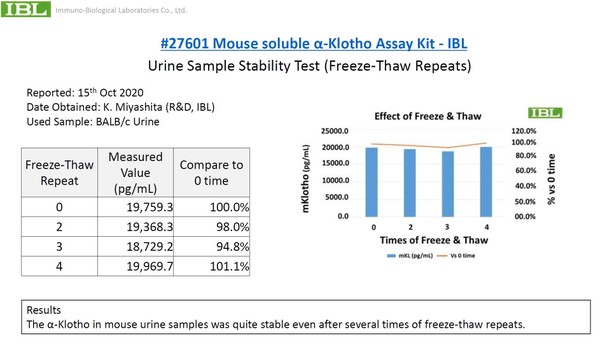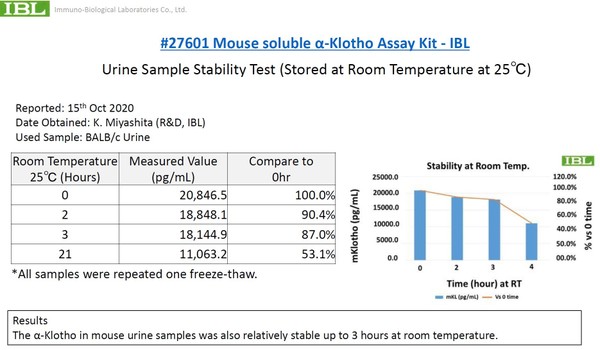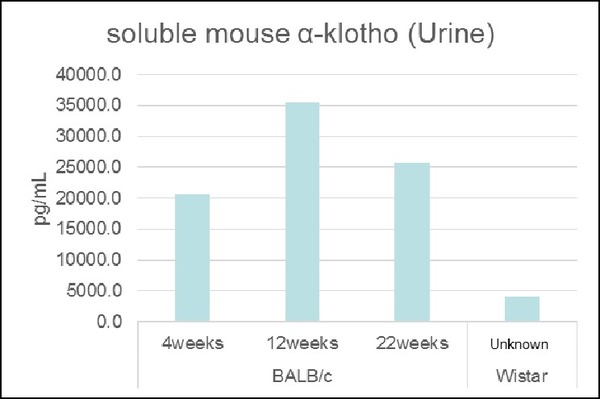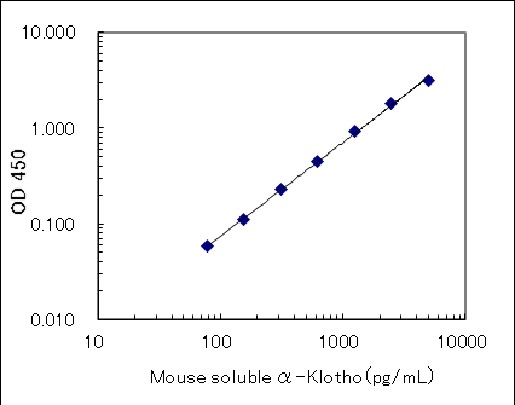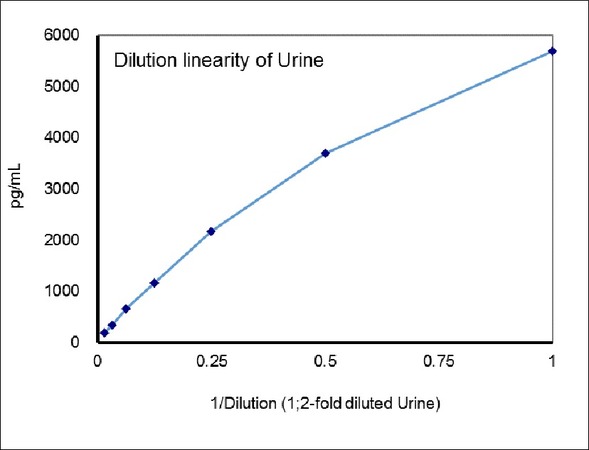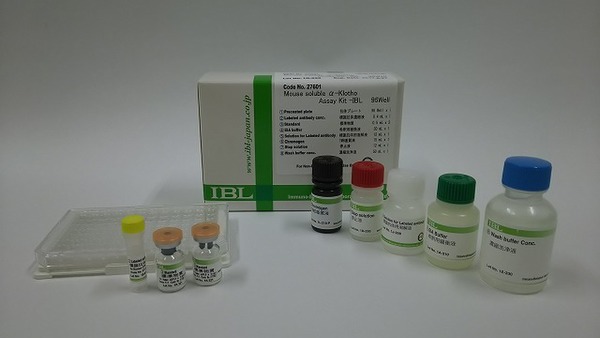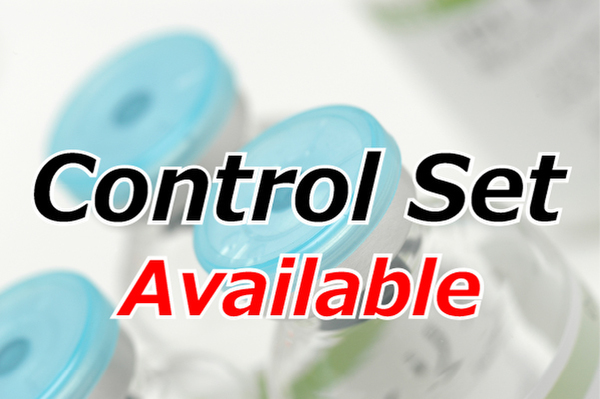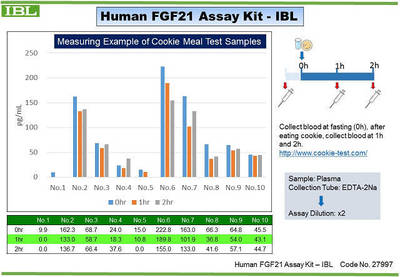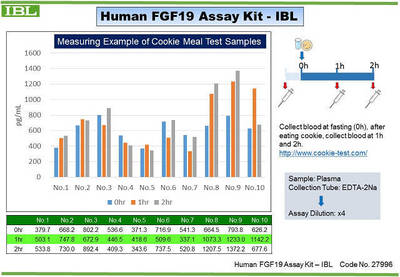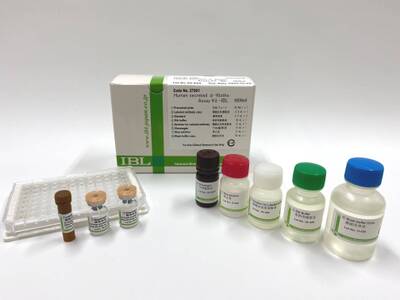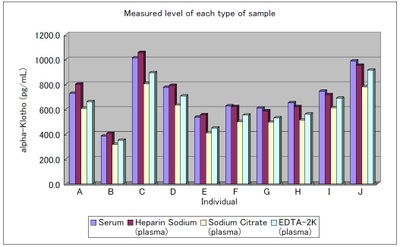- HOME >
- For Researchers >
- Product Search >
- Search Result >
- #27601 Mouse soluble α-Klotho Assay Kit - IBL
Product Search
#27601 Mouse soluble α-Klotho Assay Kit - IBL
- Intended Use:
- Research reagents
- Measuring Method:
- ELISA
- Sample Types:
- Mouse
- Measuring Samples:
- Urine
- Measurement Range:
- 78.13 ~ 5000 pg/mL
- Package Size1:
- 96 Well
※ The product indicated as "Research reagents" in the column Intended Use cannot be used
for diagnostic nor any medical purpose.
※ The datasheet listed on this page is sample only. Please refer to the datasheet
enclosed in the product purchased before use.
Product Overview
Product Overview
| Product Code | 27601 |
|---|---|
| Product Name | Mouse soluble α-Klotho Assay Kit - IBL |
| Maker Name | Immuno-Biological Laboratories Co., Ltd. |
| Intended Use | Research reagents |
| Measuring Method | ELISA |
| Conjugate | HRP |
| Species | Mouse |
| Measuring Samples | Urine |
| Measurement Range | 78.13 ~ 5000 pg/mL |
| Primary Reaction | 60 minutes at 37 ℃ |
| Secondary Reaction | 30 minutes at 2 - 8 ℃ |
| Sensitivity | 18.06 pg/mL |
| Specificity | Mouse soluble α-Klotho 100% Mouse soluble α-Klotho(KL1) 100% Mouse soluble β-Klotho ≦0.1% Human soluble α-Klotho ≦0.1% Rat soluble α-Klotho N.T |
| Storage Condition | 2 - 8 ℃ |
| Poisonous and Deleterious Substances | Not Applicable |
| Cartagena | Not Applicable |
| Measuring Service | Available |
| Package Size 1 | 96 Well |
Product Description
Product Description
α-klotho (Alpha Klotho) was identified as an extremely down-regulated gene in the genetically-modified mouse of which phenotype is very similar to various symptoms of human aging. Then, the sequences of Alpha Klotho genes have been identified in various species including humans based on the one of mouse. Alpha Klotho protein is a 130 kDa, one-transmembrane protein and its expression is confirmed in the kidneys and the parathyroid glands. In recent years, it has become clear that Alpha Klotho is an important molecule within a living organism regulating the metabolism of mineral such as calcium and phosphorus. Therefore, it is considered that, in Alpha Klotho mouse, early aging-like symptoms are induced by impaired mineral homeostasis caused by decreased expression of Alpha Klotho. Meanwhile, it is reported that the long N-terminal extracellular domain which comprises the major portion of sequence of Alpha Klotho protein is released free into blood by shedding. However, there are many unclear points about functions and changes in concentration of free (soluble) Alpha Klotho protein, so it has been required to develop the measurement system of Alpha Klotho. This ELISA kit can measure mouse soluble Alpha Klotho protein in mouse urine.
The control set is available for sale on request. Learn More
Keywords:
α-Klotho / Alpha Klotho / FGF23 / Kidney disease / Chronic Kidoeny disease (CKD) / Mineral Bone Disease (MBD) / Osteoporosis / Aging / Alzheimer's Disease
The control set is available for sale on request. Learn More
Keywords:
α-Klotho / Alpha Klotho / FGF23 / Kidney disease / Chronic Kidoeny disease (CKD) / Mineral Bone Disease (MBD) / Osteoporosis / Aging / Alzheimer's Disease
References
References
- Differential toxicity profile of secreted and processed α-Klotho expression over mineral metabolism and bone microstructure. Roig-Soriano J et al. Sci Rep. 2023 Mar 14;13(1):4211.PMID: 36918615
- Orally-active, clinically-translatable senolytics restore α-Klotho in mice and humans. Zhu Y et al. EBioMedicine. 2022 Mar;77:103912.PMID: 35292270
- Enhanced Klotho availability protects against cardiac dysfunction induced by uraemic cardiomyopathy by regulating Ca 2+ handling. Navarro-García JA et al. Br J Pharmacol. 2020 Oct;177(20):4701-4719.PMID: 32830863
Note: Retrieve by PMID number in displayed by abstract: http://www.ncbi.nlm.nih.gov
FAQ
FAQ
-
 Q.What is recommended dilution ratio?
Q.What is recommended dilution ratio? -
 A.8 fold dilution is acceptable for the measurement, however, we recommend to dilute mouse urine sample more than 16 fold to avoid the data becomes range over.
A.8 fold dilution is acceptable for the measurement, however, we recommend to dilute mouse urine sample more than 16 fold to avoid the data becomes range over. -
 Q.Can rat sample be used for this kit?
Q.Can rat sample be used for this kit? -
 A.No, it cannot.
A.No, it cannot. -
 Q.How mouse urine sample can be stored?
Q.How mouse urine sample can be stored? -
 A.It should be stored at -80℃ immediately after collection.
A.It should be stored at -80℃ immediately after collection. -
 Q.Is stability data available?
Q.Is stability data available? -
 A.It is available on the following relevant product page as images.
A.It is available on the following relevant product page as images.
http://www.ibl-japan.co.jp/en/search/product/detail/id=4678 -
 Q.Can this kit measure mouse blood sample?
Q.Can this kit measure mouse blood sample? -
 A.No, it cannot.
A.No, it cannot. -
 Q.How can we collect mouse urine sample?
Q.How can we collect mouse urine sample? -
 A.The method of collection of mouse urine is listed on the relevant product page.
A.The method of collection of mouse urine is listed on the relevant product page.
Please refer to the Pamphlet 2 listed on the page.
http://www.ibl-japan.co.jp/en/search/product/detail/id=4678 -
 Q.What are the epitopes of pre-coated antibody (Anti-mouse Klotho 162A1 Rat IgG) and HRP conjugated antibody (Anti-mouse Klotho 235A1 Rat IgG Fab')?
Q.What are the epitopes of pre-coated antibody (Anti-mouse Klotho 162A1 Rat IgG) and HRP conjugated antibody (Anti-mouse Klotho 235A1 Rat IgG Fab')? -
 A.Klotho has two domains (KL1 and KL2). Although we have not conducted epitope mapping, these antibodies can detect KL1 domains.
A.Klotho has two domains (KL1 and KL2). Although we have not conducted epitope mapping, these antibodies can detect KL1 domains.
The kit was tested using culture supernatants expressing only KL1 of mouse Klotho and has shown a positive response. -
 Q.Can dog sample (blood or urine) be used for this kit?
Q.Can dog sample (blood or urine) be used for this kit? -
 A.No it cannot.
A.No it cannot. -
 Q.Is composition of EIA buffer of each ELISA kit all same? Can it be mixed to use?
Q.Is composition of EIA buffer of each ELISA kit all same? Can it be mixed to use?
ELISA common FAQ -
 A.No it isn't. As constitute of each EIA buffer is different, it cannot be mixed with other lots or EIA buffers contained in other kind of ELISA kits.
A.No it isn't. As constitute of each EIA buffer is different, it cannot be mixed with other lots or EIA buffers contained in other kind of ELISA kits. -
 Q.What is the composition of concentrated wash buffer?
Q.What is the composition of concentrated wash buffer?
ELISA common FAQ -
 A.It contains ordinary Tween and phosphate buffer (0.05% Tween-20 in PB).
A.It contains ordinary Tween and phosphate buffer (0.05% Tween-20 in PB). -
 Q.What is the feature of the plate?
Q.What is the feature of the plate?
ELISA common FAQ -
 A.We use plate that is flat bottom and removable strip type plate (8wellx 12 strips).
A.We use plate that is flat bottom and removable strip type plate (8wellx 12 strips). -
 Q.Can I re-use standard after reconstitution?
Q.Can I re-use standard after reconstitution?
ELISA common FAQ -
 A.Not recommended to re-use standard after reconstitution. Please use it at once after the reconstitution.
A.Not recommended to re-use standard after reconstitution. Please use it at once after the reconstitution.
Please note that there are some exceptions. One time freeze-thaw the standard is acceptable for use after reconstitution for some ELISAs.
Please check the details on each product datasheet. -
 Q.What is different between reagent blank and test sample blank?
Q.What is different between reagent blank and test sample blank?
ELISA common FAQ -
 A.Reagent blank means a well is only added EIA buffer and the purpose is confirming whether the Test sample value is influenced by lack of washing process or other operations. Test sample blank means a well is added EIA buffer and HRP antibody and the purpose is to calculate the background.
A.Reagent blank means a well is only added EIA buffer and the purpose is confirming whether the Test sample value is influenced by lack of washing process or other operations. Test sample blank means a well is added EIA buffer and HRP antibody and the purpose is to calculate the background. -
 Q.How many samples can be measured by this kit?
Q.How many samples can be measured by this kit?
ELISA common FAQ -
 A.The pre-coated plate contained in our ELISA kit is 96 wells plate. We recommend to use 16 wells (2 slits) for standard and 80 wells (10 slits) for 40 samples in duplicate.
A.The pre-coated plate contained in our ELISA kit is 96 wells plate. We recommend to use 16 wells (2 slits) for standard and 80 wells (10 slits) for 40 samples in duplicate. -
 Q.What is LOD (Limit of Detection)?
Q.What is LOD (Limit of Detection)?
ELISA common FAQ -
 A.It (LOD) is defined as sensitivity that is calculated using the NCCSL method. Please refer to a datasheet of each product.
A.It (LOD) is defined as sensitivity that is calculated using the NCCSL method. Please refer to a datasheet of each product. -
 Q.What is LOQ (Limit of Quantification)?
Q.What is LOQ (Limit of Quantification)?
ELISA common FAQ -
 A.It (LOQ) is the lowest value of measurement (standard) range. Please refer to a datasheet of each product.
A.It (LOQ) is the lowest value of measurement (standard) range. Please refer to a datasheet of each product. -
 Q.What is the definition of Over Night (O/N) reaction?
Q.What is the definition of Over Night (O/N) reaction?
ELISA common FAQ -
 A.It means that the reaction is required more than 16 hours unless otherwise specifically defined it on a datasheet of each ELISA product.
A.It means that the reaction is required more than 16 hours unless otherwise specifically defined it on a datasheet of each ELISA product. -
 Q.What is the specification of quality control for ELISA product release?
Q.What is the specification of quality control for ELISA product release?
ELISA common FAQ -
 A.The information of specification is available on individual lot specific CoA. Please contact us with your reference lot number for obtaining of specific CoA.
A.The information of specification is available on individual lot specific CoA. Please contact us with your reference lot number for obtaining of specific CoA. -
 Q.What is the number (e.g. 432143214321) at the edge of strips of the plate?
Q.What is the number (e.g. 432143214321) at the edge of strips of the plate?
ELISA common FAQ -
 A.According to the plate maker (ThermoFisher), it does not have any specific meaning as it is just the number of molds.
A.According to the plate maker (ThermoFisher), it does not have any specific meaning as it is just the number of molds. -
 Q.How to wash an ELISA plate?
Q.How to wash an ELISA plate?
ELISA common FAQ -
 A.Washing it by an auto-washer is highly recommended.
A.Washing it by an auto-washer is highly recommended.
If it is not available, please refer to the demo video (only 2 mins) using a washing bottle. -
 Q.The wells turned black during the test with the kit.
Q.The wells turned black during the test with the kit.
ELISA common FAQ -
 A.It is possible that the wells were not washed sufficiently during the washing process after the HRP-labeled antibody reaction.
A.It is possible that the wells were not washed sufficiently during the washing process after the HRP-labeled antibody reaction.
Be sure to wash the wells enough times as described in the data sheet with washing buffer of more than 350 µL. -
 Q.How do you define the acceptance range of quality control of control sets?
Q.How do you define the acceptance range of quality control of control sets?
Control Set Common FAQ -
 A.In principal, it is defined as ±15%-20% based the standard value described on each datasheet.
A.In principal, it is defined as ±15%-20% based the standard value described on each datasheet. -
 Q.What is the shelf life of control set?
Q.What is the shelf life of control set?
Control Set Common FAQ -
 A.The shelf life is 12 months upon the goods is dispatched from our lab if the goods is unopned.
A.The shelf life is 12 months upon the goods is dispatched from our lab if the goods is unopned. -
 Q.What is the storage condition of control sets?
Q.What is the storage condition of control sets?
Control Set Common FAQ -
 A.It should be stored under chilled condition (2~10℃).
A.It should be stored under chilled condition (2~10℃). -
 Q.Can the control set be used after reconstitution?
Q.Can the control set be used after reconstitution?
Control Set Common FAQ -
 A.No it cannot be re-used after the reconstitution.
A.No it cannot be re-used after the reconstitution. -
 Q.What is the package form of control sets?
Q.What is the package form of control sets?
Control Set Common FAQ -
 A.It is lyophilized form.
A.It is lyophilized form.

